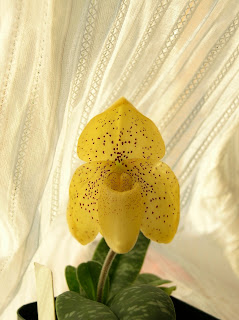Stapelia gigantea, or Carrion Flower, Starfish Flower, and several others.
The species originates from South Africa, but has been in cultivation for a long time. Ironically, though called Carrion Flower and reported to have a very foul scent, I have never noticed it. I have no explanation for this, really. Perhaps it is only horribly stinky early in the morning when I am not yet alive. That said, it is always popular with the flies, so I might have a different story if I had to be in a small, enclosed space with it.
I have recently learned that his succulent-type plant is actually a member of the milkweed family. This perhaps gives reason for its vigorous growth, a habit well known among that family. The plant is really easy to grow and flower, though newly rooted cuttings sometimes must establish themselves a year or two before they will bloom.
The plant is well known for the flower size, with a 10-12" wingspan. Here's a wine cork for comparison. The flowers in the photo are very reflexed, having all their sepals folded back, which in this case gives the impression of a smaller flower. So, natural spread is not always 10-12".
Yes, those are sepals. The petals are the tiny doodads in the center.
As mentioned, the plant is a weed, and scrambles over the edges of a pot in no time. These flowers were all on one section of stem that was well over the edge of the pot and the basket in which it was sitting. Their combined weight got to be too much. You can see it breaking off below.
But, no worries. These are really easy to root. It actually already has little pimply 'nubs' where the roots are prepared to pop out. After the flowers are gone, I'll break it off, give that piece a few days to heal the wound, then set it on something fluffy, fertile, and relatively well drained. It'll be a brand new bushy succulent in no time.





